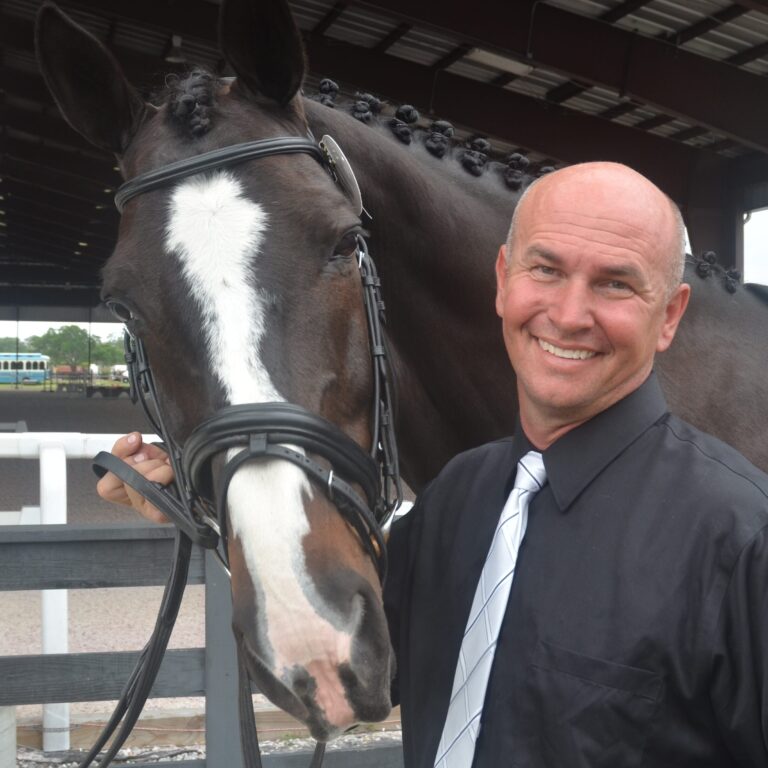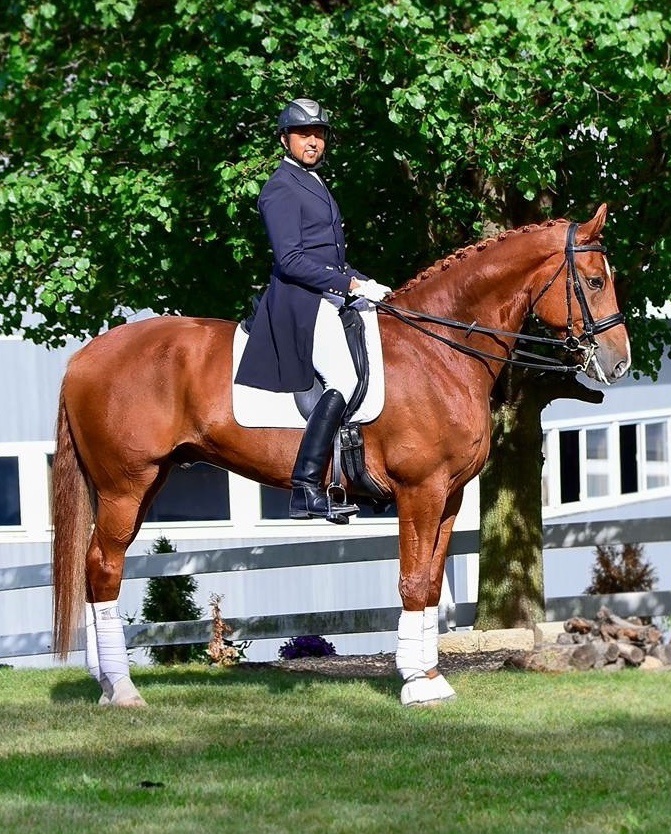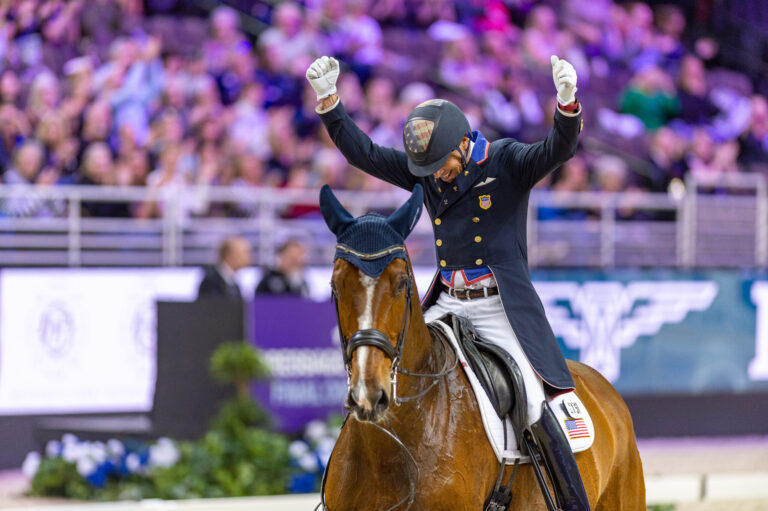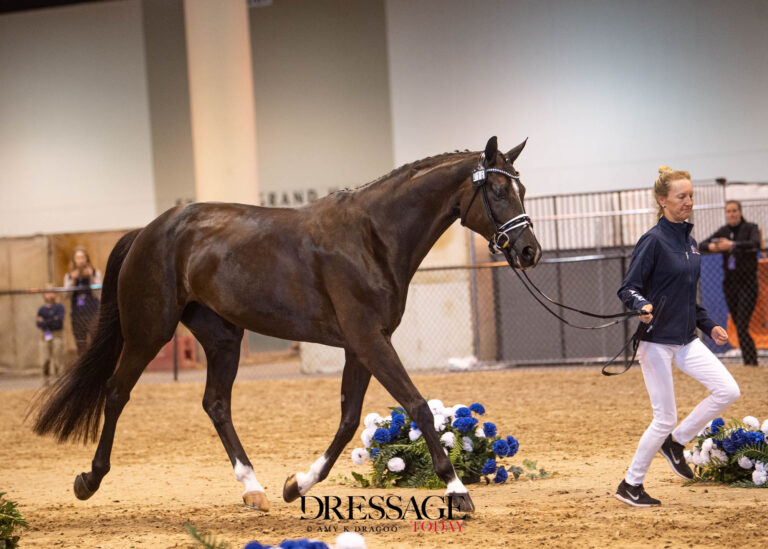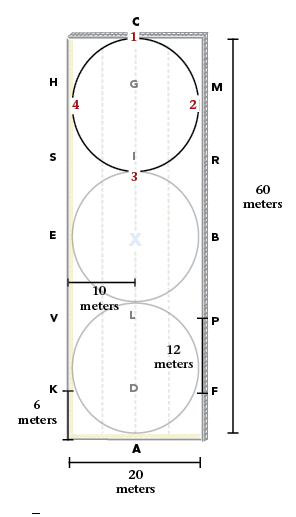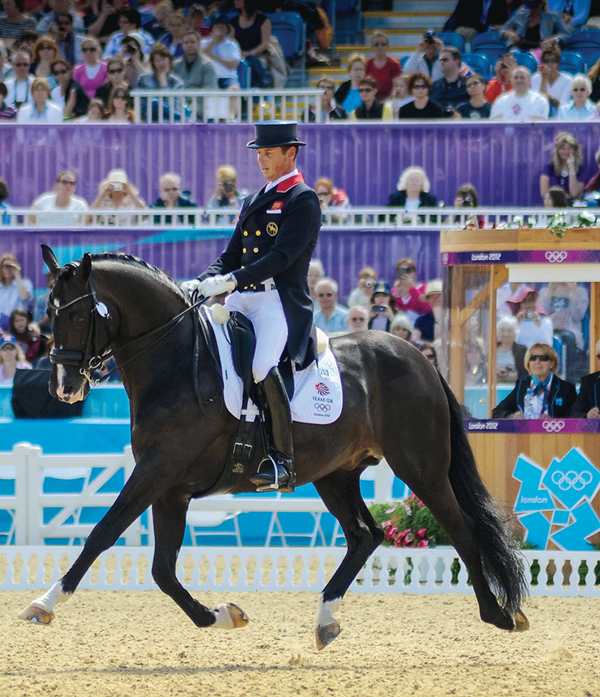
At the 1996 Atlanta Olympics, where the dressage freestyle made its ground-breaking Games debut, Robert Dover suggested to me that the competition dress code could be more relaxed, with a wider variety of styles and colors at the least and the innovations could become more daring as time went on. It sounded interesting to me, so I then dutifully trotted up to Reiner Klimke, perhaps the most eminent figure in the sport at that time, and asked him what he thought. The German, who wowed America with his brilliant gold-medal performances on Ahlerich in the 1984 Los Angeles Olympics, listened tight-lipped to what I had to say. Then he fixed me with a piercing look and said, sternly emphasizing each word, “This is NOT circus!”
Klimke died in 1999, before the word “bling” was in general circulation. I wonder what he would make of the current trend toward glitter. I think I know, though, how he would have responded to a few comments tossed around that perhaps costumes might be worn for rides to music in competition. His response wouldn’t be pretty, I feel quite sure of that.
Nearly two decades after my conversation with Klimke, things have loosened up considerably regarding dressage dress, especially for the freestyle under the lights. Still, the subject continues to be a regular topic during meetings of the FEI Dressage Committee, when its members discuss the sport’s future.
As the FEI mulls over ways to make all its disciplines more up to date and popular—always with an eye toward keeping the sport in the Olympics—there is still a line being drawn with the word “tradition,” which continues to be cited when it comes to determining the rules on dress.
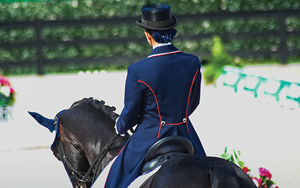
“I don’t know how far we’ll go,” mused Thomas Baur, of Germany, deputy chair of the committee. “I think some modernization will be on the way. I still don’t know what it will look like in the end. A lot of the stakeholders, like riders, trainers and organizers, agree that we want to go on the modern side. From my point of view, it is not really a need because we already have the possibility in the rules to use other colors [for tailcoats], and more or less nobody is using that. But others see the need, so I think it will come.”
He did add, “I’m a bit afraid of seeing an orange tailcoat in a championship, though there seems no danger of that in the immediate future. But a few more years on—who knows?” How far it will go is a matter to ponder.
British Olympic team gold medalist Carl Hester, the mentor of Charlotte Dujardin and one of Valegro’s owners, sees several angles of the dress issue, having spent many years competing before the bling barrage. “I’ve lived on the other side of it,” he said, when asked about his feelings on the loosening of the dress code. “I feel quite happy about the way that it’s moving. I enjoy the tradition of it, understandably, as I know a lot of other people do. The only people who don’t seem to want to look forward to the new image that I think is going to have to happen at some stage are probably those people who have never lived through the era of very traditional dress.
“I’ve managed to come through a transition, I feel, into slightly blingy,” he continued, adding he doesn’t, however, see himself in a place where he would utilize bling in excess.
Hester added, “I think it looks good. If we are talking about bringing new people into dressage and new spectators into dressage, they will be, I think, more happy to see that than the old, stuffy image. For embracing new people, it’s going to have to happen.”
Canadian rider Jacqueline Brooks noted there is a real question about the way to modernize the sport while still maintaining some of its traditions. “That’s a difficult balance,” she said. “We should be allowed to express our individuality, but where is that line between a sport and a spectacle?” she wondered.
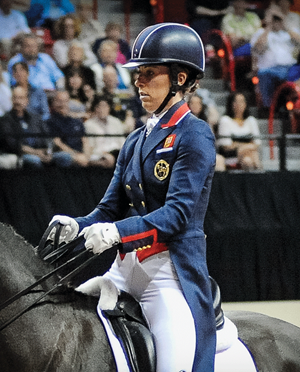
Brooks thinks blinged-out browbands look beautiful, but it is possible to take it too far. “When you are getting into reins, stirrup leathers and stirrups, then the tradition is lost,” she said. On the other hand, she says, “wool tailcoats are so not up to speed with our sport. Some of the newest fabrics are amazing.” Even so, Brooks feels that the tradition of the sport can be lost when riders take it too far.
Catherine Haddad Staller, however, seems to support a different mindset when discussing the international dressage community. “There’s been a lot of talk about making the sport more appealing to spectators,” she said. Haddad Staller herself favors a coat made from shiny material for her evening appearances. “When we stick with drab, very military-looking dress, it doesn’t have a lot of appeal. I don’t want to turn it into a costume class by any means, but I do think if you can add a bit of bling, especially if you’re showing under lights at night, if you can add some crystals here and there, a sparkly material, a sparkle on a boot or a spur, I think it really livens things up. I’m not a person who wants somebody to go out there looking like the Rhinestone Cowboy at all, but I do think we have to loosen up our rules about dress, so we can make a more appealing picture out there.”
Things have changed a great deal since the 2007 World Cup Final in Las Vegas, Nevada, when Haddad Staller requested permission to step slightly out of the norm and wear a brown shadbelly. The ground jury said no.
These days, different colors and patterns are dressing up tailcoats for freestyles and rhinestones are no longer strangers to the arena. There are, however, those who think they should be used judiciously.
“If it promotes the beauty of the horse, then it’s fine,” said Dover, now the U.S. technical advisor and chef d’equipe. “If it takes away from the beauty of the animal and the gaits of the dancing that’s going on, then it’s not fine. That’s in regard to what I believe we should be thinking of as a standard.” Dover said that he thinks that the underlying question revolves around whether the attire promotes the beauty of the sport or detracts from it. “That’s the key to the entire thing,” he said. “I don’t think it’s a clear-cut answer.
“If it becomes extreme to the point where you can’t even look at the horse because you’re so busy looking at the plush velvet with the 15 different colors of the rider, then it’s not to the advantage of the rider because the horse stops being the biggest part of the picture. If it enhances the overall beauty of the combination, then I think it’s all good.”
Dover’s predecessor in the technical advisor’s job, Anne Gribbons, who is also an international judge, had a similar sentiment. “Bling in small amounts and in the right places, I think, can enhance both the horse and the rider,” she said. “When it’s done in a classy way, a way that is not in your face, it’s fine and it’s fun,” she continued. “There’s a limit,” she said, however. In Gribbons’ opinion, too much sparkle on saddle pads, browbands and used in abundance on tailcoats is where she draws the line.
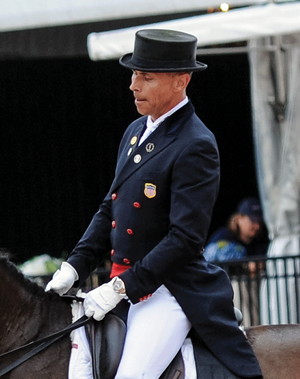
“When [bling] comes at you in all its glory and then the test isn’t so good, it’s almost a negative influence,” she pointed out. “There’s so much glitter and bling, and you expect great things, and if they don’t happen, it’s a little bit flattening. It could actually work against you if you’re not careful,” Gribbons warned. A change she would like to see in dress would be a sportier, more modern-type coat that she contends would go better with helmets than do the tails. She considers the pairing of tailcoats and helmets bizarre. “No designer in the world would put that combination together,” she said.
The more experienced riders understand the value of moderation that Gribbons emphasized and they include some conservative voices in the Grand-Prix ranks who just want to ramp up their clothing a little.
“I like that the sport is evolving,” said Canadian Olympic medalist Ashley Holzer. “A little something special for a freestyle at night is nice as long as it’s age- and arena-appropriate. I like that people are having fun with the sport, but I’m not at the age where I want to come in with a lot of bling. These younger girls and guys that are coming out, they have a little more pizzazz on them.”
Not everyone, of course, exercises the same discretion. “I totally agree with the FEI that we’ve got to put a limit on it,” said Pan American Games double-gold medalist Steffen Peters.
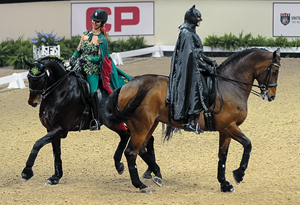
As one of the minority in the U.S. still wearing a top hat instead of a helmet for major competitions, he noted, “If it’s too sparkly, too bright, that’s not my personal taste.”
Although Peters wears a helmet for warm-up and some national classes, he prefers a top hat for international competition as a number of top Europeans and U.S. riders still do, including Lisa Wilcox, Lars Petersen and Haddad Staller. World Number One Charlotte Dujardin always wears a helmet. When she did so among a sea of top hats when taking double gold at the 2012 Olympics, it was a matter for much comment.
At one point, Peters wore a forward-looking shadbelly with cross over fastening, but is now in a more traditional style with a sponsorship from Cavalleria Toscana. He did note that eventer Will Faudree asked him for his former shadbelly and is wearing it. “I’m very happy it’s still being used,” Peters said.
U.S.-based Danish rider Petersen has updated his look, but only slightly. “I’m a little old-fashioned. I have a coat now with little stripes in it. That’s probably as far as I’ll take it,” he chuckled. “I don’t want it to become circus too much,” he said.
Pan American Games team gold medalist Kimberly Herslow has an edging of rhinestones on her boots, yet she doesn’t go crazy with the shiny stuff. “As far as the bling, I like to keep it not overdone,” she commented. “I like a little for myself, and Reno [Rosmarin] has his browband with the blue crystals. But generally, I like to keep it tasteful. I think it sometimes can be a bit overdone and too much just looks gaudy.”
There are ways Herslow chooses to express herself without too much glimmer, she noted. “I have a new shadbelly that has points that you can change to make them conservative or a bit more fun and bright. I like to switch it up so it’s not always the same. Still have to keep it classy, though,” Herslow said.
Olympic medalist Wilcox agrees that bling can be nice, but says it is important to maintain a classical flair. “Be respectful to the sport,” she said. “Bling looks great when it sparkles at night… [but] I don’t think we need to go in the direction of the circus in the color of the coats.” She prefers to put sparkle on her mounts rather than herself. “I like my boys to be the ones everyone’s looking at, and I just disappear into the saddle.”
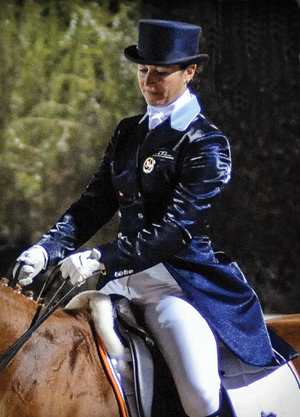
There are, however, times when adding more than a touch of show business has its place in the big picture of attempting to popularize the discipline, even if that place is not in the competition arena.
Steward Elisabeth Williams recalled that costumed freestyles worked well as an exhibition during the World Cup Final in Las Vegas last spring. “I think it is good the more we can show the crowds that dressage can be fun while we show them the beautiful horses and the beautiful movements. I think the crowd just loved it because there were a lot of people in there maybe who didn’t know so much about dressage and think it’s a boring thing to watch. Well, this is not boring. I don’t know if we’re ready for the competition freestyles to go quite this wild, but I’m not totally against the different colored coats, the different colored boots, the bling on helmets or whatever because I think we need to do something to keep the interest.”
Asked whether he thought we will one day see costumes in the freestyle, Baur was as definite as Klimke had been. “I hope that never will happen,” he stated firmly.
“We are a traditional sport and we should stick to our roots. We should not become members of the circus.”


